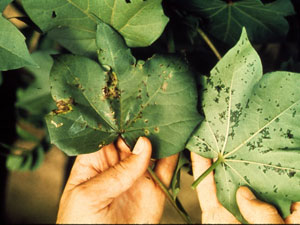Taking an environmentally sensitive approach to pest management
Bacterial Blight Damaging Cotton in Southeast Missouri
Published: August 1, 2011
Symptoms of bacterial blight have been observed on cotton plants in many southeast Missouri fields during the last 14 days. The symptoms are black, angular-shaped spots on leaves. These spots are slightly smaller than a pencil eraser, and many spots may merge to kill large parts of leaves. The lesions are visible on both sides of the leaf but are more pronounced on the upper side. The diseased tissue will remain black, and the infected leaves will defoliate if infection is severe. Currently, most of the disease is on lower leaves. This disease will probably not lower yield if it only damages a few lower leaves, but it will lower yield if it spreads to upper leaves and especially if it spreads to bolls and causes boll rot. I have seen no research results that show this disease can be managed at this stage by treatment of the plants with a bactericide or fungicide. However, farmers can take action to minimize spread of this disease to top leaves and bolls by restricting plant growth through aggressive use of growth regulators. This disease will be worse on rank-growth cotton because the bacteria spread more when leaves are wet due to a combination of high humidity and dew that stays on leaves until late morning. Air circulates well through small plants, 30 inches tall, and this helps lower the humidity in the crop canopy so dew dries more rapidly in the morning.

This disease is caused by bacteria, and it was a problem in many cotton fields in the U.S. until the late 1970's when seed companies began acid delinting seed. This process killed the bacteria survived on the seed. I am not sure why this disease has developed this year. There are rumors that some of the seed companies have changed their delinting process, and the bacterial on seed were not killed. You may contact me for more information.
Subscribe to receive similar articles sent directly to your inbox!
REVISED: October 2, 2015